Supramammillary glutamate neurons are a key node of the arousal system
- PMID: 29123082
- PMCID: PMC5680228
- DOI: 10.1038/s41467-017-01004-6
Supramammillary glutamate neurons are a key node of the arousal system
Abstract
Basic and clinical observations suggest that the caudal hypothalamus comprises a key node of the ascending arousal system, but the cell types underlying this are not fully understood. Here we report that glutamate-releasing neurons of the supramammillary region (SuMvglut2) produce sustained behavioral and EEG arousal when chemogenetically activated. This effect is nearly abolished following selective genetic disruption of glutamate release from SuMvglut2 neurons. Inhibition of SuMvglut2 neurons decreases and fragments wake, also suppressing theta and gamma frequency EEG activity. SuMvglut2 neurons include a subpopulation containing both glutamate and GABA (SuMvgat/vglut2) and another also expressing nitric oxide synthase (SuMNos1/Vglut2). Activation of SuMvgat/vglut2 neurons produces minimal wake and optogenetic stimulation of SuMvgat/vglut2 terminals elicits monosynaptic release of both glutamate and GABA onto dentate granule cells. Activation of SuMNos1/Vglut2 neurons potently drives wakefulness, whereas inhibition reduces REM sleep theta activity. These results identify SuMvglut2 neurons as a key node of the wake-sleep regulatory system.
Conflict of interest statement
The authors declare no competing financial interests.
Figures
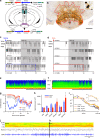

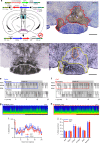
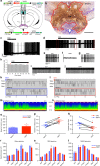
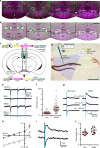

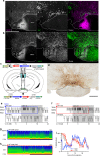

Similar articles
-
GABA-glutamate supramammillary neurons control theta and gamma oscillations in the dentate gyrus during paradoxical (REM) sleep.Brain Struct Funct. 2020 Dec;225(9):2643-2668. doi: 10.1007/s00429-020-02146-y. Epub 2020 Sep 24. Brain Struct Funct. 2020. PMID: 32970253 Free PMC article.
-
Differential origin of the activation of dorsal and ventral dentate gyrus granule cells during paradoxical (REM) sleep in the rat.Brain Struct Funct. 2017 Apr;222(3):1495-1507. doi: 10.1007/s00429-016-1289-7. Epub 2016 Aug 18. Brain Struct Funct. 2017. PMID: 27539452 Free PMC article.
-
Regulation of states of consciousness by supramammillary nucleus glutamatergic neurones during sevoflurane anaesthesia in mice.Br J Anaesth. 2025 Feb;134(2):425-440. doi: 10.1016/j.bja.2024.10.023. Epub 2024 Dec 6. Br J Anaesth. 2025. PMID: 39645516
-
[Selective stimulations and lesions of the rat brain nuclei as the models for research of the human sleep pathology mechanisms].Glas Srp Akad Nauka Med. 2011;(51):85-97. Glas Srp Akad Nauka Med. 2011. PMID: 22165729 Review. Serbian.
-
Selective activation of a few limbic structures during paradoxical (REM) sleep by the claustrum and the supramammillary nucleus: evidence and function.Curr Opin Neurobiol. 2017 Jun;44:59-64. doi: 10.1016/j.conb.2017.03.002. Epub 2017 Mar 24. Curr Opin Neurobiol. 2017. PMID: 28347885 Review.
Cited by
-
Extreme Neuroplasticity of Hippocampal CA1 Pyramidal Neurons in Hibernating Mammalian Species.Front Neuroanat. 2019 Feb 13;13:9. doi: 10.3389/fnana.2019.00009. eCollection 2019. Front Neuroanat. 2019. PMID: 30814935 Free PMC article. Review.
-
The vicious interplay between disrupted sleep and malignant brain tumors: a narrative review.Croat Med J. 2021 Aug 31;62(4):376-386. doi: 10.3325/cmj.2021.62.376. Croat Med J. 2021. PMID: 34472741 Free PMC article. Review.
-
Hypothalamic Glutamate/GABA Cotransmission Modulates Hippocampal Circuits and Supports Long-Term Potentiation.J Neurosci. 2021 Sep 29;41(39):8181-8196. doi: 10.1523/JNEUROSCI.0410-21.2021. Epub 2021 Aug 11. J Neurosci. 2021. PMID: 34380766 Free PMC article.
-
Distinct release properties of glutamate/GABA co-transmission serve as a frequency-dependent filtering of supramammillary inputs.Elife. 2024 Dec 16;13:RP99711. doi: 10.7554/eLife.99711. Elife. 2024. PMID: 39680436 Free PMC article.
-
Intersectional mapping of multi-transmitter neurons and other cell types in the brain.Cell Rep. 2022 Jul 5;40(1):111036. doi: 10.1016/j.celrep.2022.111036. Cell Rep. 2022. PMID: 35793636 Free PMC article.
References
-
- Economo VonC. Sleep as a problem of localization. J. Nerv. Ment. Dis. 1930;71:249–259. doi: 10.1097/00005053-193003000-00001. - DOI
-
- Ranson SW. Somnolence after hypothalamic lesions in monkeys. Arch. Neurol. Psychiatry. 1939;41:1–23. doi: 10.1001/archneurpsyc.1939.02270130011001. - DOI
-
- Nauta WJH. Hypothalamic regulation of sleep in rats; an experimental study. J. Neurophysiol. 1946;9:285–316. - PubMed
Publication types
MeSH terms
Substances
Grants and funding
LinkOut - more resources
Full Text Sources
Other Literature Sources
Molecular Biology Databases

